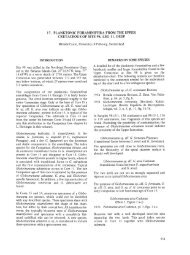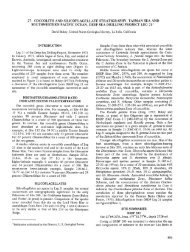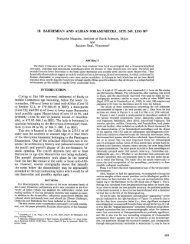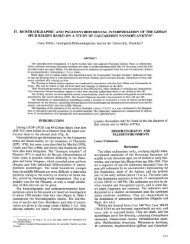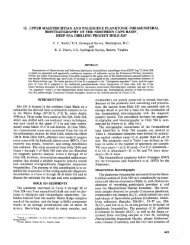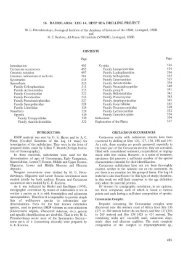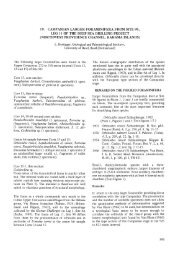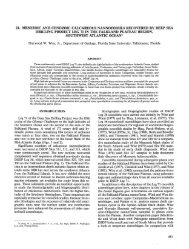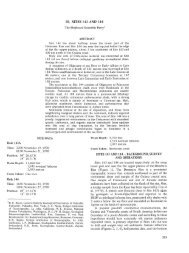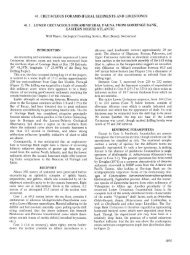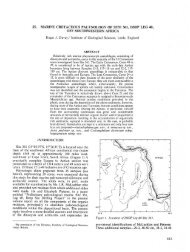1 - Deep Sea Drilling Project
1 - Deep Sea Drilling Project
1 - Deep Sea Drilling Project
You also want an ePaper? Increase the reach of your titles
YUMPU automatically turns print PDFs into web optimized ePapers that Google loves.
Mesocena triangula (Ehrenberg) Ehrenberg, 1844<br />
(Plate 6, Figures 9-10)<br />
Remarks: This roundly triangular species has distal pikes at the<br />
apices and is consistently ornamented with many tiny pikes along the<br />
distal margin of the body ring. It occurs rarely in Miocene and Pliocene<br />
samples<br />
Genus OCTACTIS Schiller, 1925<br />
Octactis pulchra Schiller, 1925<br />
(Plate 6, Figures 11-12)<br />
Remarks: This symmetric octagonal species is dominated by the<br />
body ring and distal spines. It occurs only rarely in Quaternary samples.<br />
It is common in some late Pleistocene and Holocene core samples from<br />
the Black <strong>Sea</strong> (Bukry, unpublished data) and was originally described in<br />
living populations from the Adriatic <strong>Sea</strong>.<br />
Study Methods<br />
DIATOMS<br />
Core samples tabulated for diatoms are from the same<br />
fractions, greater than 44 microns, used in the silicoflagellate<br />
study. These were separated to facilitate study of<br />
larger diatoms present at low levels of abundance. Preparations<br />
of the fraction less than 44 microns, which are<br />
more poorly preserved than the coarse fraction, typically<br />
contain common to abundant fragments of the elongate<br />
diatom genera Thalassiothrix and Thalassionema and lack<br />
many distinctive species characterizing the coarser fractions.<br />
In the diatom stratigraphic tabulations and general<br />
interpretations, which are based only on the coarse fractions,<br />
the letters A, C, M, and R indicate the relative<br />
abundance of each species (Tables 9, 10, and 11). A is used<br />
for abundant occurrences, Cfor common occurrences, M<br />
for meager occurrences (intermediate between common<br />
and rare), and R if only one to four specimens are found<br />
on a sample slide. Scanning of the 40 X 20 mm slide areas<br />
was done at magnifications of 100 and 250 ×.<br />
Paleoenvironmental Interpretation<br />
All diatom assemblages examined are dominated by<br />
oceanic, tropical to subtropical species. Only a single<br />
predominantly cool-water species, Coscinodiscus curvatulus<br />
Grunow [see Lohman, 1941; Hendey, 1964], has<br />
TABLE 9<br />
Diatoms Greater Than 44 Microns in Size at DSDP 157A<br />
Sample<br />
lA-2(8-10 cm)<br />
lA-4(8-10 cm)<br />
1A(CC)<br />
2A(CC)<br />
3A(CC)<br />
Taxa<br />
RM R ACM MCR A<br />
RM RC RM RA<br />
RRR AMM RC M<br />
R MR A M RR<br />
C RARM RM<br />
SILICOFLAGELLATE AND DIATOM STRATIGRAPHY<br />
been identified. The consistent dominance of restricted<br />
warm-water taxa [Groups I and V of Kanaya and<br />
Koizumi, 1966] suggests that the abundance of the elongate<br />
diatoms Thalassionema and Thalassiothrix is indicative<br />
of upwelling and resultant productivity, not<br />
necessarily of cool-water conditions as has been suggested<br />
(Hendey, 1937). Both of the principal species of elongate<br />
diatoms in the Panama Basin, Thalassionema nitzschioides<br />
and Thalassiothrix longissima, have been recorded as minor<br />
living components in the Pacific Ocean Subarctic<br />
group of Venrick (1971), but not of the Central Pacific<br />
group; nutrient enrichment is higher in the Subarctic area.<br />
Denticula, a common genus in Neogene high-latitude<br />
cool-water assemblages, is missing from all but Miocene<br />
assemblages in the Panama Basin. Actual temperature<br />
fluctuations in the basin were probably small during the<br />
late Neogene. The Miocene and Pliocene occurrences of<br />
C. curvatulus and temperate-water Actinocyclus ehrenber-<br />
£/•/Ralfs [see Lohman, 1941] indicate that these taxa were<br />
then more cosmopolitan, or that Panama Basin waters<br />
may have been slightly cooler. Because the sample interval<br />
for this study is 9 meters (about 200,000-year increments<br />
for the Pleistocene at DSDP 157), short-term incursions<br />
of cool-water species might be as yet undetected. The<br />
consistent dominance of oceanic, warm-water species in<br />
the samples examined is, however, the most significant<br />
feature of the Panama Basin diatom assemblages.<br />
Genera that are considered to be characteristic of<br />
coastal or nearshore areas can be used to indicate the<br />
presence of displaced shallow-water deposits, which may<br />
result from erosion during glacial periods of lowered sea<br />
level or from turbid-flow deposition. Representatives of<br />
such genera—Auliscus, Aulacodiscus, Biddulphia, Diploneis,<br />
Grammatophora, Navicula, Pleurosigma, and<br />
Surirella—are rare and sporadic in their occurrence, indicating<br />
normal pelagic deposition at DSDP 157 and<br />
DSDP 158.<br />
The state of preservation varies to some extent and is<br />
best reflected by degree of solution and by the relative<br />
diversity of the assemblages. For example, no diatoms are<br />
present in DSDP 157 below Core 38, which contains hard<br />
chert. Diatom silica in deeper sediment was presumably<br />
remobilized during formation of the chert, because diversity<br />
and preservation of diatoms are fairly good directly<br />
above. Hemidiscus cuneiformis is represented by both<br />
whole valves and open girdle bands. Although thinning of<br />
the areolae structure of valves can be observed in several<br />
species, no intermediate stages between open girdle bands<br />
and thinned areolae has been observed. No attempt has<br />
been made to gauge various degrees of preservation, but<br />
Kamatani (1971) has stated that, "The rate of dissolution<br />
of diatomaceous silica varies considerably between species."<br />
Therefore the species diversity of an assemblage and<br />
possibly the percentage of open girdle bands could be<br />
combined to estimate a range of preservation states.<br />
Tropical Diatom Zonation<br />
Biostratigraphic zonation based on oceanic diatom assemblages<br />
is a relatively new field. Stratigraphic subdivisions<br />
of Pacific Ocean sediment by diatoms have been<br />
indicated recently by Kanaya (1971), Kanaya and<br />
829



